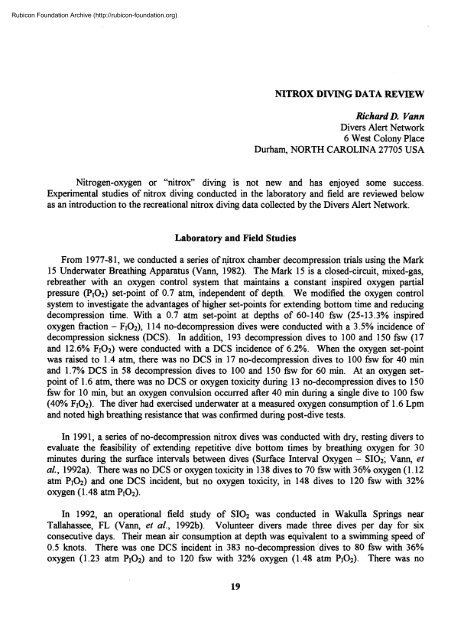Nitrox workshop dings - Divers Alert Network
Nitrox workshop dings - Divers Alert Network
Nitrox workshop dings - Divers Alert Network
You also want an ePaper? Increase the reach of your titles
YUMPU automatically turns print PDFs into web optimized ePapers that Google loves.
Rubicon Foundation Archive (http://rubicon-foundation.org)NITROX DIVING DATA REVIEWRichard D. Vann<strong>Divers</strong> <strong>Alert</strong> <strong>Network</strong>6 West Colony PlaceDurham, NORTH CAROLINA 27705 USANitrogen-oxygen or "nitrox" diving is not new and has enjoyed some success.Experimental studies of nitrox diving conducted in the laboratory and field are reviewed belowas an introduction to the recreational nitrox diving data collected by the <strong>Divers</strong> <strong>Alert</strong> <strong>Network</strong>.Laboratory and Field StudiesFrom 1977-81, we conducted a series of nitrox chamber decompression trials using the Mark15 Underwater Breathing Apparatus (Vann, 1982). The Mark 15 is a closed-circuit, mixed-gas,rebreather with an oxygen control system that maintains a constant inspired oxygen partialpressure (P1O2) set-point of 0.7 atm, independent of depth. We modified the oxygen controlsystem to investigate the advantages of higher set-points for extending bottom time and reducingdecompression time. With a 0.7 atm set-point at depths of 60-140 fsw (25-13.3% inspiredoxygen fraction - F1O2), 114 no-decompression dives were conducted with a 3.5% incidence ofdecompression sickness (DCS). In addition, 193 decompression dives to 100 and 150 fsw (17and 12.6% F1O2) were conducted with a DCS incidence of 6.2%. When the oxygen set-pointwas raised to 1.4 atm, there was no DCS in 17 no-decompression dives to 100 fsw for 40 minand 1.7% DCS in 58 decompression dives to 100 and 150 fsw for 60 min. At an oxygen setpointof 1.6 atm, there was no DCS or oxygen toxicity during 13 no-decompression dives to 150fsw for 10 min, but an oxygen convulsion occurred after 40 min during a single dive to 100 fsw(40% F1O2). The diver had exercised underwater at a measured oxygen consumption of 1.6 Lpmand noted high breathing resistance that was confirmed during post-dive tests.In 1991, a series of no-decompression nitrox dives was conducted with dry, resting divers toevaluate the feasibility of extending repetitive dive bottom times by breathing oxygen for 30minutes during the surface intervals between dives (Surface Interval Oxygen - SIO2; Vann, etal, 1992a). There was no DCS or oxygen toxicity in 138 dives to 70 fsw with 36% oxygen (1.12atm P1O2) and one DCS incident, but no oxygen toxicity, in 148 dives to 120 fsw with 32%oxygen (1.48 atm PiO 2 ).In 1992, an operational field study of SIO2 was conducted in Wakulla Springs nearTallahassee, FL (Vann, et al., 1992b). Volunteer divers made three dives per day for sixconsecutive days. Their mean air consumption at depth was equivalent to a swimming speed of0.5 knots. There was one DCS incident in 383 no-decompression dives to 80 fsw with 36%oxygen (1.23 atm P1O2) and to 120 fsw with 32% oxygen (1.48 atm P1O2). There was no19
















